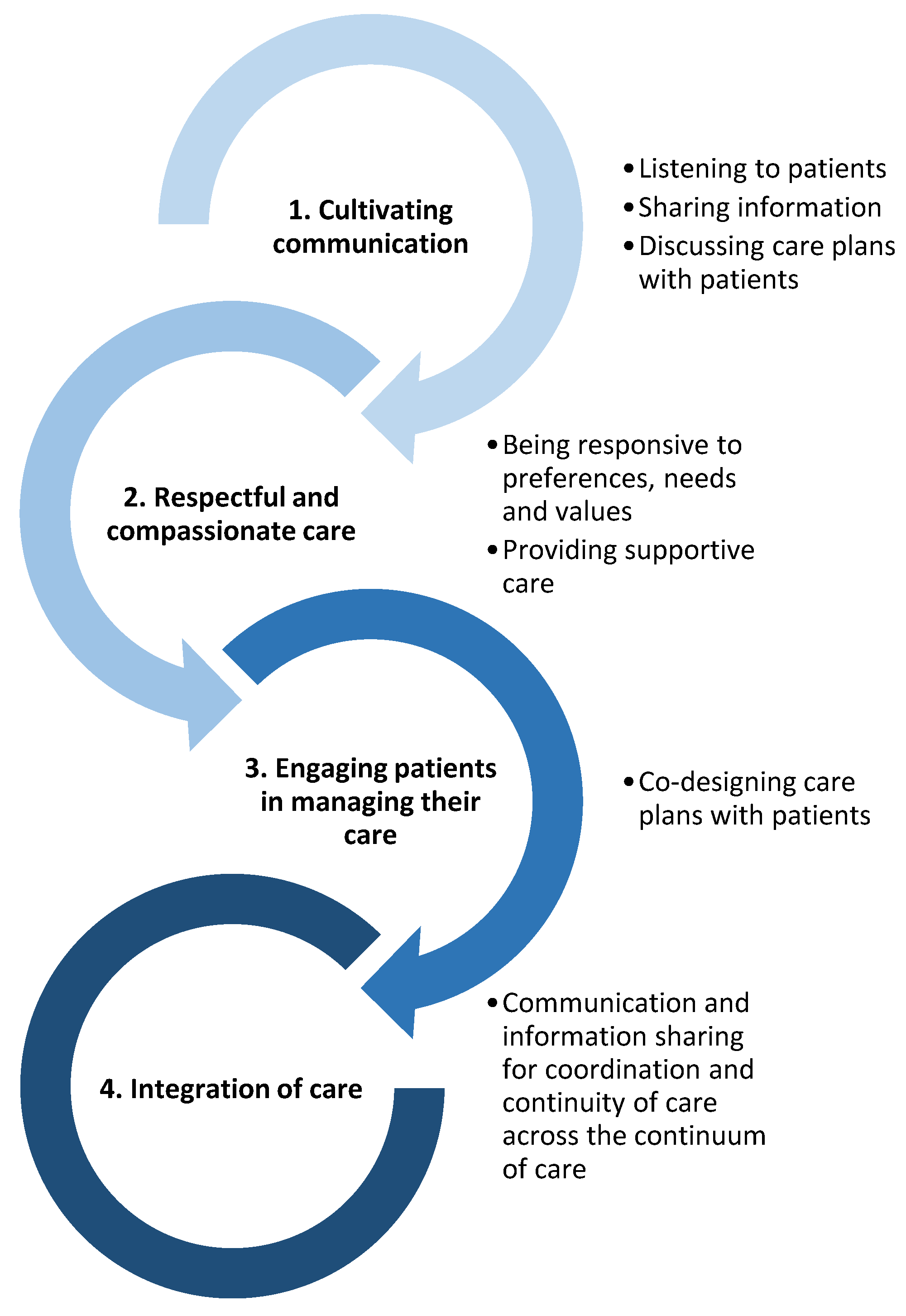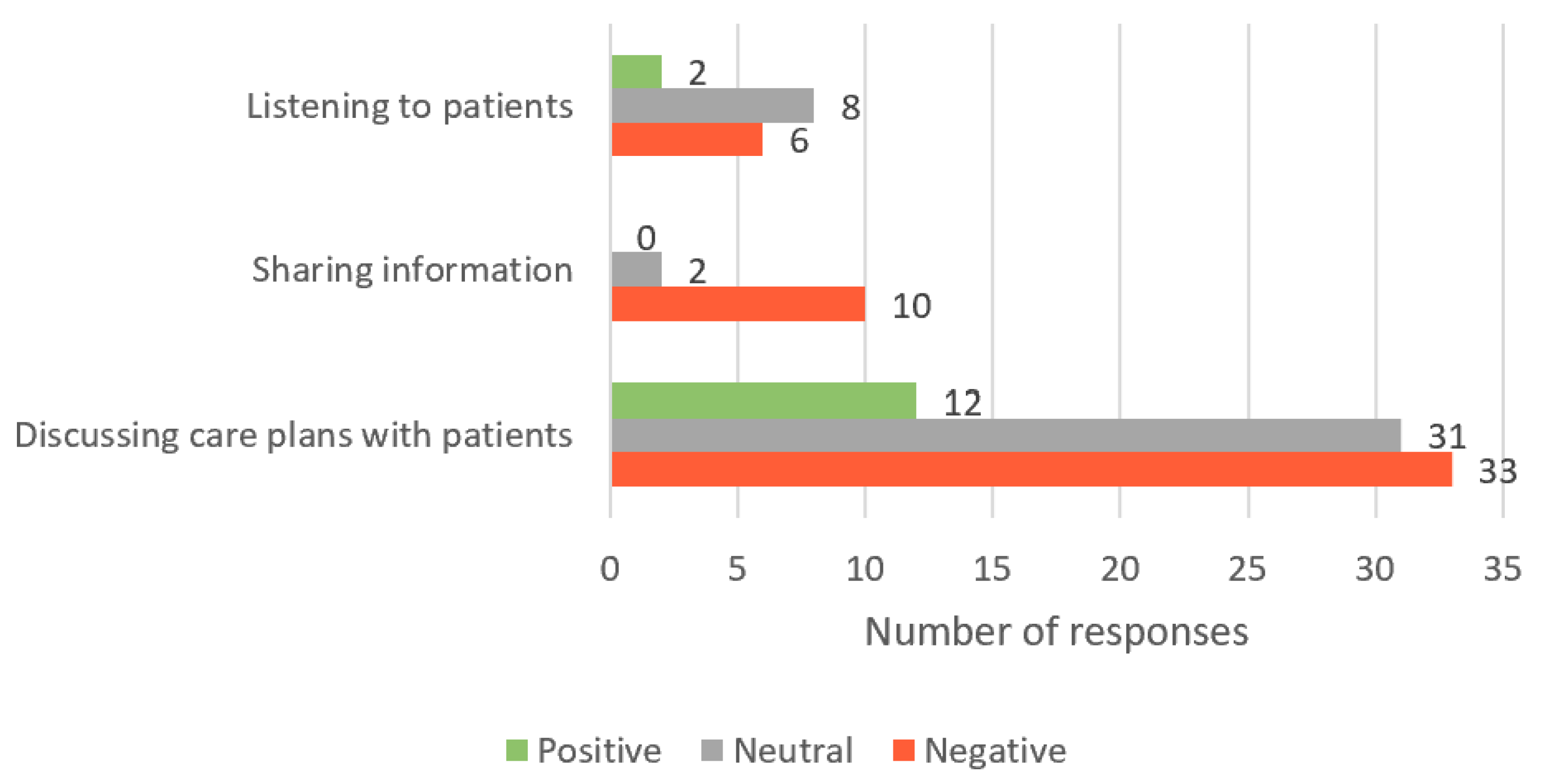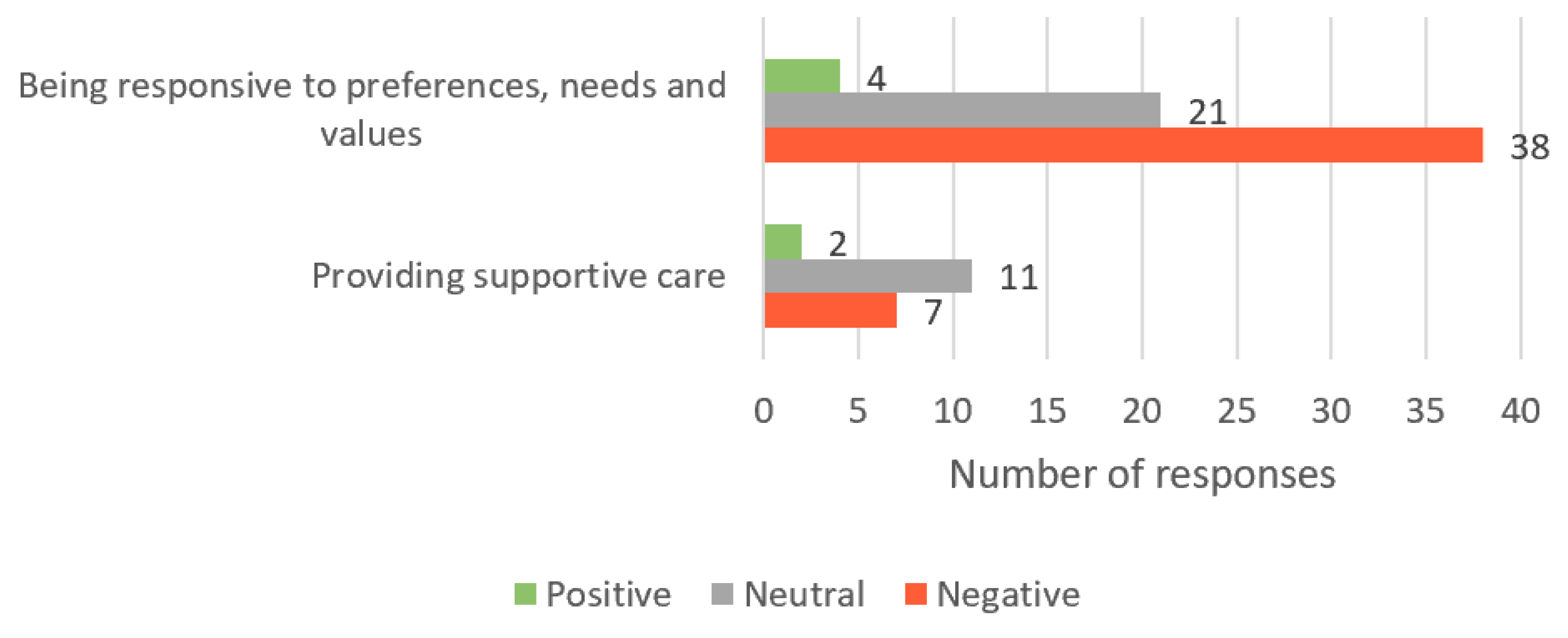What Do Students’ Questionnaire Responses Tell Us about Their Language around Person-Centred Care? An Exploratory Sentiment Analysis
Abstract
:1. Introduction
2. Materials and Methods
2.1. Overview
2.2. Questionnaire Development
2.3. Participants and Recruitment
2.4. Analysis and Reporting
3. Results
3.1. Demographics
3.2. Overview
3.3. Cultivating Communication
3.4. Respectful and Compassionate Care
3.5. Engaging Patients in Managing Their Care
3.6. Integration of Care
4. Discussion
4.1. Strengths and Limitations
4.2. Future Research
5. Conclusions
Supplementary Materials
Author Contributions
Funding
Institutional Review Board Statement
Informed Consent Statement
Data Availability Statement
Acknowledgments
Conflicts of Interest
References
- World Health Organization. People-Centred Health Care: A Policy Framework; World Health Organization: Geneva, Switzerland, 2007. [Google Scholar]
- Ekman, I.; Swedberg, K.; Taft, C.; Lindseth, A.; Norberg, A.; Brink, E.; Carlsson, J.; Dahlin-Ivanoff, S.; Johansson, I.-L.; Kjellgren, K. Person-centered care—Ready for prime time. Eur. J. Cardiovasc. Nurs. 2011, 10, 248–251. [Google Scholar] [CrossRef] [PubMed]
- Eklund, J.H.; Holmström, I.K.; Kumlin, T.; Kaminsky, E.; Skoglund, K.; Höglander, J.; Sundler, A.J.; Condén, E.; Meranius, M.S. “Same same or different?” A review of reviews of person-centered and patient-centered care. Patient Educ. Couns. 2019, 102, 3–11. [Google Scholar] [CrossRef]
- World Health Organization. WHO Global Strategy on Integrated People-Centred Health Services 2016–2026; World Health Organization: Geneva, Switzerland, 2015. [Google Scholar]
- Australian Commission on Safety and Quality in Health Care. Rationale and Approaches to Person-Centred Care. Available online: https://www.safetyandquality.gov.au/our-work/partnering-consumers/person-centred-care/rationale-and-approaches-person-centred-care (accessed on 29 November 2022).
- Finset, A. Research on person-centred clinical care. J. Eval. Clin. Pract. 2011, 17, 384–386. [Google Scholar] [CrossRef]
- Oates, J.; Weston, W.W.; Jordan, J. The impact of patient-centered care on outcomes. Fam. Pract. 2000, 49, 796–804. [Google Scholar]
- Paparella, G. Person-Centred Care in Europe: A Cross-Country Comparison of Health System Performance, Strategies and Structures; Picker Institute Europe: Oxford, UK, 2016. [Google Scholar]
- Pharmaceutical Society of Australia. Professional Practice Standards (Version 5); ACT: Canberra, Australia, 2017. [Google Scholar]
- Pharmaceutical Society of Australia. Professional Practice Standards (Version 4); ACT: Canberra, Australia, 2010. [Google Scholar]
- Nursing and Midwifery Board of Australia. Registered Nurse Standards for Practice; Nursing and Midwifery Board of Australia: Melbourne, Australia, 2016.
- Australian Commission on Safety and Quality in Health Care. Patient-Centred Care: Improving Quality and Safety through Partnerships with Patients and Consumers; ACSQHC: Sydney, Australia, 2011. [Google Scholar]
- Happell, B.; Waks, S.; Bocking, J.; Horgan, A.; Manning, F.; Greaney, S.; Goodwin, J.; Scholz, B.; van der Vaart, K.J.; Allon, J. ‘There’s more to a person than what’s in front of you’: Nursing students’ experiences of consumer taught mental health education. Int. J. Ment. Health Nurs. 2019, 28, 950–959. [Google Scholar] [CrossRef] [PubMed]
- Saunders, A.; Green, R.; Cross, M. Making the most of person-centred education by integrating flipped and simulated teaching: An exploratory study. Nurse Educ. Pract. 2017, 27, 71–77. [Google Scholar] [CrossRef] [PubMed]
- WHO Regional Office for Europe. Health Literacy: The Solid Facts; WHO Regional Office for Europe: Copenhagen, Denmark, 2013. [Google Scholar]
- Wood, H.; Brand, G.; Clifford, R.; Kado, S.; Lee, K.; Seubert, L. Student Health and Social Care Professionals’ Health Literacy Knowledge: An Exploratory Study. Pharmacy 2023, 11, 40. [Google Scholar] [CrossRef]
- Eysenbach, G. Improving the quality of Web surveys: The Checklist for Reporting Results of Internet E-Surveys (CHERRIES). J. Med. Internet. Res. 2004, 6, e34. [Google Scholar] [CrossRef]
- Ratzan, S.; Parker, R.; Selden, C.; Zorn, M. Health Literacy [Bibliography Online]; National Library of Medicine: Bethesda, MD, USA, 2000.
- Santana, M.J.; Manalili, K.; Jolley, R.J.; Zelinsky, S.; Quan, H.; Lu, M. How to practice person-centred care: A conceptual framework. Health Expect. 2018, 21, 429–440. [Google Scholar] [CrossRef]
- Braybrook, D.; Bristowe, K.; Timmins, L.; Roach, A.; Day, E.; Clift, P.; Rose, R.; Marshall, S.; Johnson, K.; Sleeman, K.E. Communication about sexual orientation and gender between clinicians, LGBT+ people facing serious illness and their significant others: A qualitative interview study of experiences, preferences and recommendations. BMJ Qual. Saf. 2022, 32, 109–120. [Google Scholar] [CrossRef]
- Giusti, A.; Pukrittayakamee, P.; Alarja, G.; Farrant, L.; Hunter, J.; Mzimkulu, O.; Gwyther, L.; Williams, N.; Wannarit, K.; Abusalem, L. Developing a global practice-based framework of person-centred care from primary data: A cross-national qualitative study with patients, caregivers and healthcare professionals. BMJ Glob. Health 2022, 7, e008843. [Google Scholar] [CrossRef]
- Cole-Lewis, H.; Pugatch, J.; Sanders, A.; Varghese, A.; Posada, S.; Yun, C.; Schwarz, M.; Augustson, E. Social listening: A content analysis of e-cigarette discussions on Twitter. J. Med. Internet. Res. 2015, 17, e4969. [Google Scholar] [CrossRef] [PubMed]
- Gabarron, E.; Dorronzoro, E.; Rivera-Romero, O.; Wynn, R. Diabetes on Twitter: A sentiment analysis. J. Diabetes Sci. Technol. 2019, 13, 439–444. [Google Scholar] [CrossRef]
- Zhang, L.; Hall, M.; Bastola, D. Utilizing Twitter data for analysis of chemotherapy. Int. J. Med. Inform. 2018, 120, 92–100. [Google Scholar] [CrossRef] [PubMed]
- van Dulmen, S. The value of tailored communication for person-centred outcomes. J. Eval. Clin. Pract. 2011, 17, 381–383. [Google Scholar] [CrossRef] [PubMed]
- Mead, N.; Bower, P. Patient-centred consultations and outcomes in primary care: A review of the literature. Patient Educ. Couns. 2002, 48, 51–61. [Google Scholar] [CrossRef]
- Yuan, S.; Freeman, R.; Hill, K.; Newton, T.; Humphris, G. Communication, trust and dental anxiety: A person-centred approach for dental attendance behaviours. Dent. J. 2020, 8, 118. [Google Scholar] [CrossRef]
- Cegala, D.J.; Street, R.L., Jr.; Clinch, C.R. The impact of patient participation on physicians’ information provision during a primary care medical interview. Health Commun. 2007, 21, 177–185. [Google Scholar] [CrossRef]
- Larson, E.; Sharma, J.; Bohren, M.A.; Tunçalp, Ö. When the patient is the expert: Measuring patient experience and satisfaction with care. Bull. World Health Organ. 2019, 97, 563. [Google Scholar] [CrossRef]
- González-Bueno, J.; Sevilla-Sánchez, D.; Puigoriol-Juvanteny, E.; Molist-Brunet, N.; Codina-Jané, C.; Espaulella-Panicot, J. Improving medication adherence and effective prescribing through a patient-centered prescription model in patients with multimorbidity. Eur. J. Clin. Pharmacol. 2022, 78, 127–137. [Google Scholar] [CrossRef]
- Cramm, J. The benefits of person centered care for professionals, patients and informal caregivers. Int. J. Integr. Care 2021, 21, 99. [Google Scholar] [CrossRef]
- Moudatsou, M.; Stavropoulou, A.; Philalithis, A.; Koukouli, S. The role of empathy in health and social care professionals. Healthcare 2020, 8, 26. [Google Scholar] [CrossRef]
- Terezam, R.; Reis-Queiroz, J.; Hoga, L.A.K. The importance of empathy in health and nursing care. Rev. Bras. Enferm. 2017, 70, 669–670. [Google Scholar] [CrossRef]
- Bertakis, K.D.; Azari, R. Patient-centered care is associated with decreased health care utilization. J. Am. Board. Fam. Med. 2011, 24, 229–239. [Google Scholar] [CrossRef] [PubMed]
- Milky, G.; Thomas, J., III. Shared decision making, satisfaction with care and medication adherence among patients with diabetes. Patient Educ. Couns. 2020, 103, 661–669. [Google Scholar] [CrossRef] [PubMed]
- Coulter, A. Patient engagement—What works? J. Ambul. Care Manag. 2012, 35, 80–89. [Google Scholar] [CrossRef] [PubMed]
- Rodriguez-Osorio, C.A.; Dominguez-Cherit, G. Medical decision making: Paternalism versus patient-centered (autonomous) care. Curr. Opin. Crit. Care 2008, 14, 708–713. [Google Scholar] [CrossRef]
- Braschi, E.; Stacey, D.; Légaré, F.; Grad, R.; Archibald, D. Evidence-based medicine, shared decision making and the hidden curriculum: A qualitative content analysis. Perspect. Med. Educ. 2020, 9, 173–180. [Google Scholar] [CrossRef]
- Harding, C.; Seal, A.; Vlok, R.; Doyle, Z.; Dean, A.; McGirr, J. Maintaining patient-centredness in Australian medical students: Culture, curriculum and selection criteria. Focus Health Prof. Educ. A Multi-Discip. J. 2022, 23, 35–50. [Google Scholar] [CrossRef]
- Rosewilliam, S.; Indramohan, V.; Breakwell, R.; Skelton, J. Learning to be patient-centred healthcare professionals: How does it happen at university and on clinical placements? a multiple focus group study. Med. Ed. Publish. 2020, 9, 53. [Google Scholar] [CrossRef]
- Australian Bureau of Statistics. Health Literacy, Australia; Australian Bureau of Statistics: Canberra, Australia, 2008.
- Wood, H.; Benino, D.; Brand, G.; Clifford, R.; Lee, K.; Seubert, L. ‘You have to have a level of trust’: Consumer-described health literacy barriers and enablers to engaging with health care professionals. Health Promot. J. Austr. 2022, 34, 173–184. [Google Scholar] [CrossRef] [PubMed]
- MacDonald, G.A.; Kayes, N.M.; Bright, F. Barriers and facilitators to engagement in rehabilitation for people with stroke: A review of the literature. N. Z. J. Physiother. 2013, 41, 112–121. [Google Scholar]
- Australian Commission on Safety and Quality in Health Care. Top Tips for Safe Health Care; ACSQHC: Sydney, Australia, 2017.
- McCormack, B.; Dewing, J. International Community of Practice for Person-centred Practice: Position statement on person-centredness in health and social care. Int. Pract. Dev. J. 2019, 9. [Google Scholar] [CrossRef]




| Age | Median 23 Years (IQR 2) | |
|---|---|---|
| Gender n (%) | Female | 61 (68%) |
| Male | 27 (30%) | |
| Unknown | 2 (2%) | |
| Degree n (%) | Pharmacy | 31 (34%) |
| Podiatric Medicine | 26 (29%) | |
| Social Work and Social Policy | 18 (20%) | |
| Nursing | 8 (9%) | |
| Dental Medicine | 7 (8%) | |
Disclaimer/Publisher’s Note: The statements, opinions and data contained in all publications are solely those of the individual author(s) and contributor(s) and not of MDPI and/or the editor(s). MDPI and/or the editor(s) disclaim responsibility for any injury to people or property resulting from any ideas, methods, instructions or products referred to in the content. |
© 2023 by the authors. Licensee MDPI, Basel, Switzerland. This article is an open access article distributed under the terms and conditions of the Creative Commons Attribution (CC BY) license (https://creativecommons.org/licenses/by/4.0/).
Share and Cite
Wood, H.; Brand, G.; Clifford, R.; Kado, S.; Lee, K.; Seubert, L. What Do Students’ Questionnaire Responses Tell Us about Their Language around Person-Centred Care? An Exploratory Sentiment Analysis. Healthcare 2023, 11, 2458. https://doi.org/10.3390/healthcare11172458
Wood H, Brand G, Clifford R, Kado S, Lee K, Seubert L. What Do Students’ Questionnaire Responses Tell Us about Their Language around Person-Centred Care? An Exploratory Sentiment Analysis. Healthcare. 2023; 11(17):2458. https://doi.org/10.3390/healthcare11172458
Chicago/Turabian StyleWood, Helen, Gabrielle Brand, Rhonda Clifford, Sinead Kado, Kenneth Lee, and Liza Seubert. 2023. "What Do Students’ Questionnaire Responses Tell Us about Their Language around Person-Centred Care? An Exploratory Sentiment Analysis" Healthcare 11, no. 17: 2458. https://doi.org/10.3390/healthcare11172458
APA StyleWood, H., Brand, G., Clifford, R., Kado, S., Lee, K., & Seubert, L. (2023). What Do Students’ Questionnaire Responses Tell Us about Their Language around Person-Centred Care? An Exploratory Sentiment Analysis. Healthcare, 11(17), 2458. https://doi.org/10.3390/healthcare11172458








